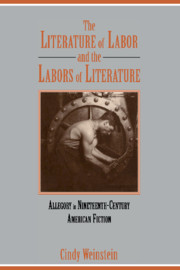 The Literature of Labor and the Labors of Literature
The Literature of Labor and the Labors of Literature Book contents
- Frontmatter
- Contents
- Acknowledgments
- Introduction
- 1 The Problem with Labor and the Promise of Leisure
- 2 Hawthorne and the Economics of Allegory
- 3 Melville's Operatives
- 4 Twain in the Man-factory
- 5 The Manikin, the Machine, and the Virgin Mary
- Afterword
- Notes
- Index
- CAMBRIDGE STUDIES IN AMERICAN LITERATURE AND CULTURE
3 - Melville's Operatives
Published online by Cambridge University Press: 06 July 2010
- Frontmatter
- Contents
- Acknowledgments
- Introduction
- 1 The Problem with Labor and the Promise of Leisure
- 2 Hawthorne and the Economics of Allegory
- 3 Melville's Operatives
- 4 Twain in the Man-factory
- 5 The Manikin, the Machine, and the Virgin Mary
- Afterword
- Notes
- Index
- CAMBRIDGE STUDIES IN AMERICAN LITERATURE AND CULTURE
Summary
In late January 1851, Herman Melville toured a paper mill in Dalton, Massachusetts, and four years later fictionalized the visit in “The Paradise of Bachelors and the Tartarus of Maids.” The narrator takes a tour of the mill in which he witnesses a frightening scene of production. He describes “a tall girl, feeding the iron animal [the paper machine] with half quires of rose-hued note paper” which “received in the corner the impress of a wreath of roses.” The traditional rosy-cheeked young girl is replaced by “pale, blue girl[s]” (327) with “pallid cheek[s]” (328) and “face[s] pale with work” (327). Work, as the debate about the Lowell mill operatives indicated, did not necessarily guarantee spiritual or economic enhancement but increasingly seemed to undermine individual agency and bodily integrity. Instead of developing character in a version of the Romantic symbol, work appeared to flatten it out in an image of Coleridgean allegory. In the tartarus of maids we witness the production of allegorical characters as the paper machine drains the rosiness of the girls' cheeks until the product takes on the quality of natural rosiness, leaving “rows of blank-looking girls, with blank, white folders in their blank hands, all blankly folding blank paper” (328). The machine has replaced Aylmer, the operatives' cheeks have replaced Georgiana's, but rosy cheeks continue to pose a problem; that is, the complex relations among work, writing, and the body remain and continue to be played out upon the bodies of allegorical characters.
- Type
- Chapter
- Information
- The Literature of Labor and the Labors of LiteratureAllegory in Nineteenth-Century American Fiction, pp. 87 - 128Publisher: Cambridge University PressPrint publication year: 1995
